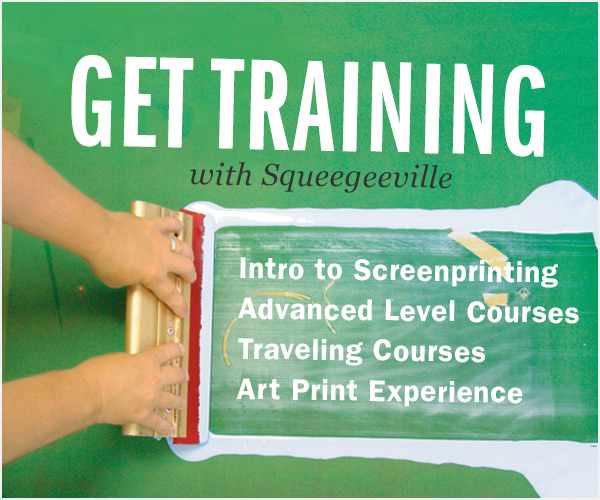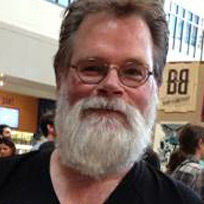Toxic Baths
I'm someone who grew up taking baths in lacquer thinner and other toxic chemicals in too many dark, poorly ventilated, stinky printing shops. It's driven me to learn how to use waterbase inks and build a custom print studio with solar exposing, proper venting, and an ergonomic workplace. I'd like to provide a few suggestions to printmaking artists who want to work in a less toxic environment, and reduce their waste production. These are mostly from the screenprinting side of the studio, but many of the ideas have crossover potential for the other printmaking processes. Lots of these ideas don't cost much money to implement, and in some cases will actually save you money over the long run.
- Pre-press... when making film, if you want to eliminate photo chemicals dump the camera and use an ink jet printer, or a laser printer on smaller non-critical work. There are now specially-treated clear materials that can sub for litho film and still give you perfect positives at good prices. Best of all, you can make them with your home computer system and a decent printer.
- Exposure... use solar (the sun) to burn screens. This eliminates the use of electricity and exotic bulbs or carbon arc.
- Washout... run the waste water through a settling tank with filter baffles (cheap low tech) or use a batch treatment filtration system with floculant style or removable filters. Make an evaporation tank if appropriate, this will keep effluent out of the wastewater stream.
- Personal safety equipment for washout or screen reclaiming... solvent resistant gloves, apron, long-sleeved shirt, face splash shield (or at the minimum safety goggles), respirator (if necessary) and ear protection.
- Inks... switch to waterbase, allows the use of water for clean-up and thinning, reduces rag use - use sponges over and over. Water base ink eliminates VOCs (volatile organic compounds) in the printing and recaiming area or your studio, and reduces the use of reclaiming chemicals.
- Tape out your screens with clear packing tape - tape your gutters andinto the screen surface close to your image, when you clean up just pullaway the tape - eliminates excess ink cleanup on the press and in the washout booth.
- If you do use solvent based inks... switch to lemon based ink degrader, allows cleanup without laquer thinner or agressive solvents.
- If you do use solvent based inks... use a respirator mask, wear solvent resistant gloves during clean-up, and put used rags outside the studio to evaporate solvents. Afterwards, dry the rags and wash with bleach, then reuse.
- If you do use solvents continued... Ventilation system suction from the floor (solvent fumes are heavier than air) near the press, and if you have drying racks, place a suction vent with a curtain shroud where you can push the racks during drying - your prints give off the most fumes as the inks harden, you can direct these to the outside with a vented drying area that captures the VOCs. There are also stand-alone airscrubbers which will filter VOCs and dust from the air, through replacement filters.
- Reclaiming... use a pressure washer, switch to biodegradible stencil remover, haze remover, and degreaser. The use of a pressure washer will allow you to use minimal amounts of the reclaiming chemicals. Personal safety equipment outlined above should always be worn for this proceedure. Also, a properly constructed backlit washout booth with a suction vent will reduce overspray and contaminants.
- Recycling ... separate garbage into used ink, paper, cardboard, and other waste. Reuse paper for set-up and test prints, then use it for wrapping and packing. Reuse cans and plastic containers for ink mixing, allow inks to dry before disposing of them, mix used or trash inks together and use as black or dark grey, try to use up left-over custom mixed inks before using new on subsequent prints.
- Clean-up... use ink knives and scrape away as much ink from the stencil area as possible, then pull away the tape to carry off the excess outside the image area. Always clean tools and equipment before inks or spills harden, you use far less cleaner and materials. When cleaning solvent-based materials, make sure to use enough cleaner to break the ink and absorb it - use one rag to first clean the screen, then wipe the squeegee, then the ink knife.
- Studio Layout... maintain designated storage areas for all tools and materials, there will be a marked reduction in waste, spillage, and accidents. Separate dirty processes from the main printing area, build in your venting to accomodate the layout, with sealed spaces if appropriate, and if you really want to get tricky, build the venting so you have positive air pressure in the room at all times, with a controlled filtered intake - this will decrease dust in the printing area, and carry away VOCs or smells quickly.
As many correspondents have correctly pointed out, there is no such thing as "no tox" in printmaking. Even water will kill you if you ingest too much of it. However, you can easily acheive improved low-toxicity in the print studio by analyzing your methods and materials, and making appropriate modifications. The goal is still to enjoy your artistic and creative freedom through printmaking, without sacrificing quality, and not harm yourself, your friends, or the environment. REDUCE your use of chemicals, solvents, rags, inks, water and power REUSE paper, inks,cardboard, sponges, water, containers, screens RECYCLE paper, cardboard, metal, and plastics.
Keep the air clean, the splashes out of your eyes, and don't lick your fingers.

